Word Walls, Sounds Walls: What’s the difference?
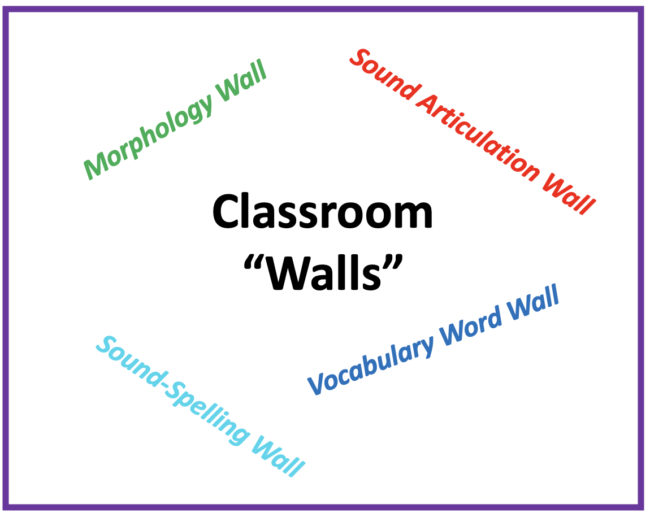
A hot topic in the field of beginning reading instruction these days is the use of classroom “walls.” Word walls, sound walls, spelling walls, morphology walls – so many different kinds of walls! Understanding the difference among these options, and the different purposes for using them can be confusing. To help clear up some of this confusion, here are some brief descriptions and examples of different types of walls:
- Vocabulary Word Wall: This kind of “wall” is a list of vocabulary terms that the teacher is teaching in-depth. The words on these lists should change frequently, sometimes with words added and taken off daily. The words are typically chosen because they support important concepts related to current subject area content and reading materials. Unusual words that students find interesting can also be included on a vocabulary word wall. The words might be in a single list, or they might be organized into categories. For essential words that teachers want students to really “own”, they need to provide multiple exposures in real contexts to those words. As Beck and colleagues note (2002), students need “rich vocabulary instruction” that includes significant discussion in a content-rich environment that offers students an opportunity to have purposeful interaction with new vocabulary words. Showing an anchor chart with a list of key words serves as a reminder to students and teachers to use these words in context. Instructional suggestions for using this type of word wall are included The Key Vocabulary Routine. The examples below are from primary grade classrooms.
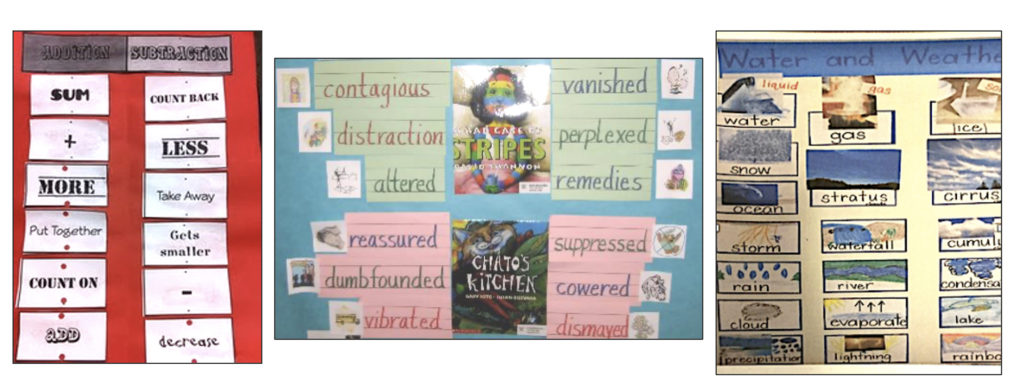
- Morphology Wall: This kind of “wall” focuses on instruction related to word parts (morphemes, including prefixes, suffixes and roots or base words). The purpose of these walls is to build students’ understanding that words are “constructed” by combining meaningful word parts, to help them build word families, and to learn common prefixes, suffixes, and roots/base words. A morphology wall can take different forms, as shown in the examples below.
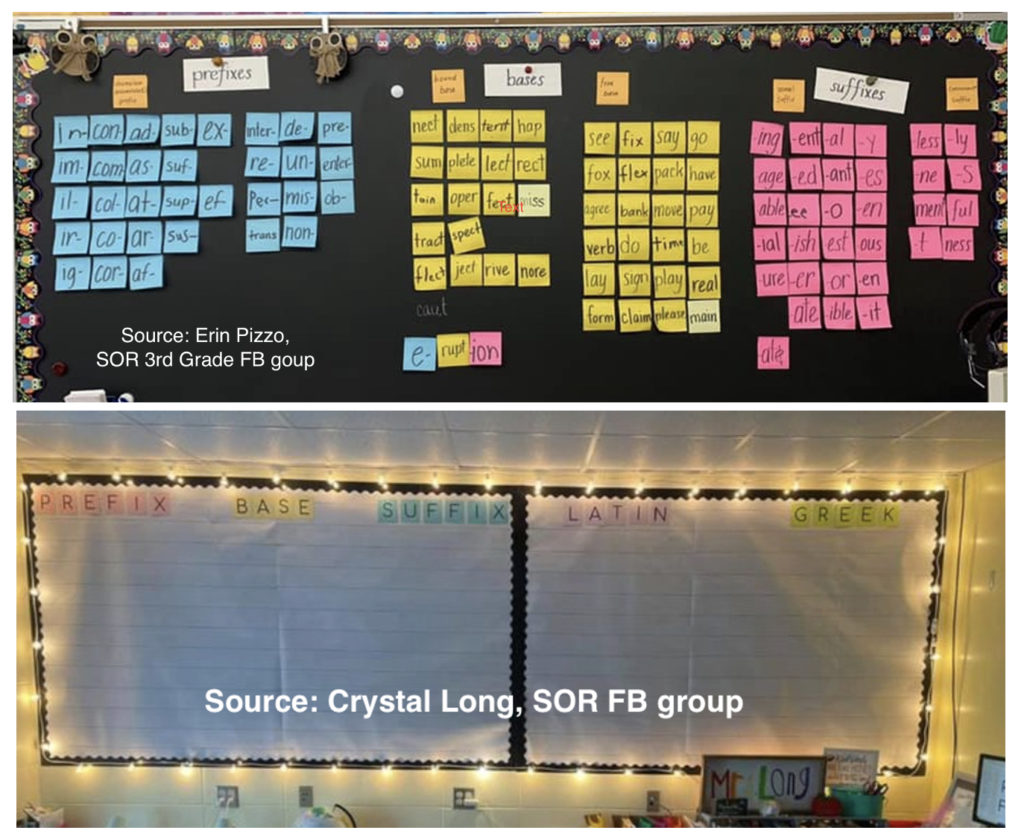
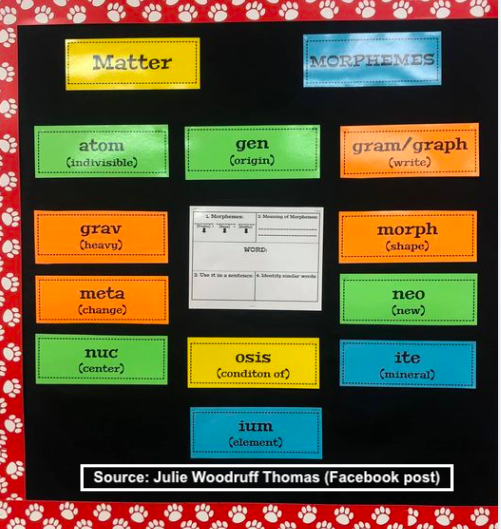
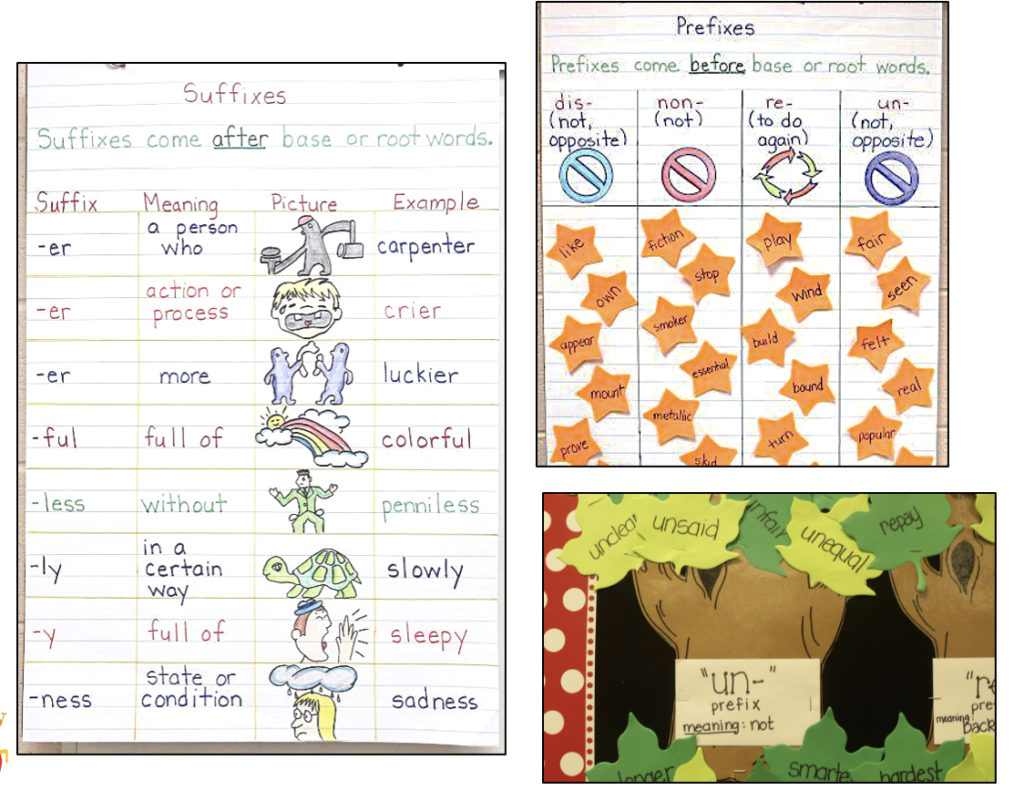
Sound-Spelling Wall: This kind of “wall” includes cards that represent speech sounds (phonemes). For each sound, a picture is provided of a word that includes that sound – 44 in total that represent phonemes in spoken English. Spellings that represent a sound are listed under the picture. See the examples below — the one on the left uses the first sound in the word “cat” as the key word prompt for the sound /k/, and 3 spellings are listed underneath (c, k, ck). The cards are usually grouped by sound – i.e., the vowel sounds together and consonant sounds together. Typically, as the teacher focuses on a specific sound, they start by teaching the most common spelling(s) (grapheme) for that sound, which are shown on the card. Less common spellings can be added as they are taught. Sound-spelling walls help students spell words based on the sounds in a word — they listen for each sound in the word, find the picture prompt word related to that sound, and can then view the different options to spell that sound. These types of walls go hand in hand with structured literacy instruction that includes explicit instruction for sound-spelling correspondences, and blending and segmenting of phonemes to decode (read) and encode (spell). And, this type of instruction supports the development of the orthographic mapping process that enables students to become fluent readers by connecting the sounds of words they already know (the phonemes) to the letters in a word (the spellings), and then storing connected sounds and letters of words (along with their meaning) as instantly recognizable words, described as “sight vocabulary” or “sight words”. A sound-spelling wall is often described as focused on the students’ point of view because it uses a speech-to-print approach that focuses on how a word sounds. View the examples below.


Sound Articulation Wall: Sound articulation “walls” display pictures of students’ mouths that show how the 44 sounds of spoken English are produced — i.e., the manner and place of articulation in the mouth. Often, these pictures are displayed alongside sound-spelling cards, to form a “wall” that covers both sound articulation and sound-spelling. The purpose of the pictures is to provide clues to students about what their mouth and tongues are doing when producing a sound. However, this type of wall will not be helpful if the teacher is not also providing explicit instruction about phoneme articulation, including helping students attend to the way their mouths look, feel and act. It also includes making sure that each sound is clearly pronounced without adding “extra sounds” — for example, making sure not to add an “uh” sound for the sound /b/, /t/, or /p/ (e.g., avoid saying /buh/, /tuh/, /puh/). The first example below shows just articulation pictures, the next examples show them combined with sound-spelling cards.
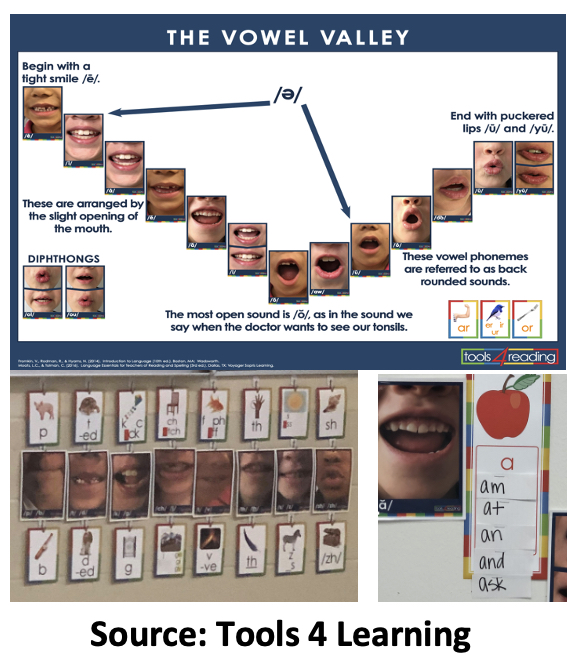
Traditional Alphabet Word Walls: These types of word walls have been found in classrooms for decades, despite not being very helpful in terms of supporting reading or spelling. With this kind of wall, words are listed under each letter of the alphabet based on the first letter of the word, typically high-frequency words. However, grouping words by their sounds instead of letters (i.e., sound-spelling walls) is much more effective. This is especially the case for words that start with a letter that does not match the sound in a word. Unless the student already knows how to read and spell the word, they will not be able to find it on the chart. For example, the word “the” would be listed under “T” but the first sound the student hears is /th/ not /t/. Another example is the word “knee“. It would be listed under “K” but the first sound the student hears is /n/, not /k/. This is why the speech-to-print approach in a sound-spelling wall is a more effective and useful kind of wall. View the example of a traditional alphabet word wall below.
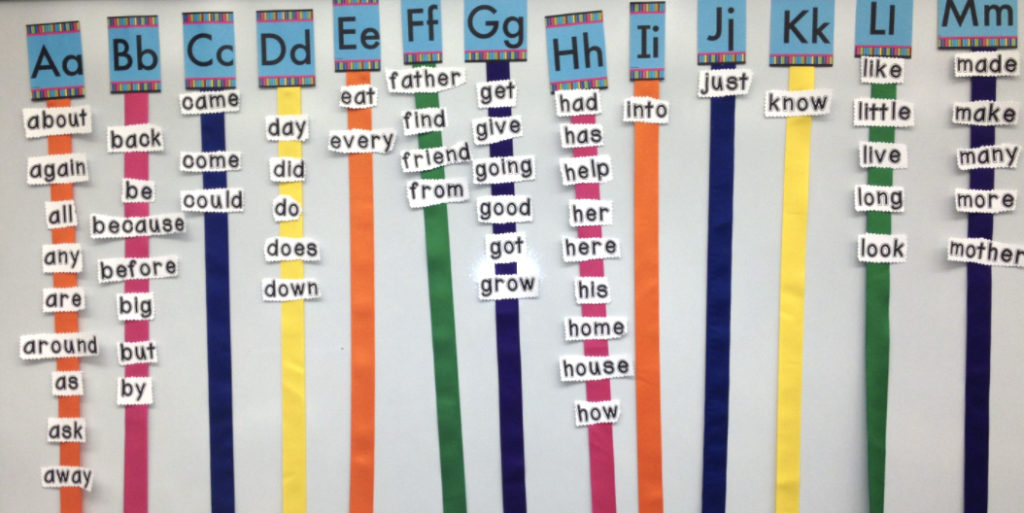
Summary: Any type of word wall will not be useful if the teacher does not reference it on a regular basis. Also, vocabulary walls need to change words (i.e., weekly) and morphology walls need to be updated as new examples of words with suffixes and prefixes are encountered in reading. If walls are not used on a regular basis, they unfortunately will become nothing more than wall paper!
Additional Resources Related to Sound Spelling and Sound Walls:
- “Transitioning from Word Walls to Sound Walls” by Marjorie Bottari, Reading Rockets
- “Sound Walls: Using the Science of Reading to Help Students Spell” (video) PaTTAN
- “Implementing a Sound Wall: Because We Need to Distinguish Between Sounds and Letters” (blog post) Mary Dahlgren
- “Putting Sound Walls to Practice” (blog post) Meredith Nardone
- Mary Dahlgren’s Tools 4 Learning website to purchase sound-spelling and articulation cards and posters.
Reference: Beck, I.L., McKeown, M.G., & Kucan, L. (2002). Bringing words to life. New York: The Guilford Press.

 Joan Sedita is the founder of Keys to Literacy and author of the Keys to Literacy professional development programs. She is an experienced educator, nationally recognized speaker and teacher trainer. She has worked for over 35 years in the literacy education field and has presented to thousands of teachers and related professionals at schools, colleges, clinics, and professional conferences.
Joan Sedita is the founder of Keys to Literacy and author of the Keys to Literacy professional development programs. She is an experienced educator, nationally recognized speaker and teacher trainer. She has worked for over 35 years in the literacy education field and has presented to thousands of teachers and related professionals at schools, colleges, clinics, and professional conferences.
Excellent explanations, Joan! I especially like the inclusion of vocabulary and morphology walls, as well as the Summary, which emphasizes that if any of the ‘walls’ are not utilized/referenced in instruction, why have them? I have found that it is hard for teachers to “let it go” in terms of some older practices–teachers, readers, listen to Joan’s wise words!!
Thanks for this information.